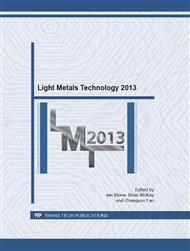p.13
p.18
p.23
p.28
p.33
p.38
p.42
p.47
p.54
Effect of Addition of Al & Ca and Heat Treatment on the Cast Mg-6Zn Alloy
Abstract:
In the present investigation, the effect of addition of Al and small amounts of Ca as well as the effect of heat treatment has been investigated on microstructure, tensile properties and corrosion behaviour of Mg-6Zn alloy produced by squeeze casting. The Mg-6Zn-1Al (ZA61) alloy consisted of α-Mg grains and MgZn (β) phase at the grain boundaries with a much higher strength and ductility than pure Mg. The addition of 0.1 and 0.5 wt% Ca to the ZA61 alloy refined the grain size and increased the volume fraction of the grain boundary phase but did not change the nature of the phase. Consequently, strength increased without much reduction in ductility. The increase in Al content of the alloy to 4 wt% (ZA64) changed the grain boundary phase to Al5Mg11Zn4 (Φ) phase, increased its volume fraction and refined the grain size as compared to ZA61 alloy. Consequently, strength increased with a reduction in ductility. On heat treatment of ZA61+0.5Ca and ZA64 alloys, the volume fraction of grain boundary phases decreased, fine precipitates were obtained in the matrix and the grain size increased. Thus, higher strength with a lower ductility was obtained on heat treatment but the ductility of both the alloys was still higher than that of pure Mg. Thus, 130 MPa 0.2%PS, 225 MPa UTS and 4.9% elongation to fracture could be obtained for the squeeze cast ZA64 alloy in the T6 condition, which are very good tensile properties for a cast Mg alloy. Increase in Al content and heat treatment reduced the corrosion resistance and addition of Ca improved it. The highest corrosion rate was observed to be 0.85 mm/year for the ZA64 alloy in the T6 condition.
Info:
Periodical:
Pages:
33-37
Citation:
Online since:
July 2013
Authors:
Keywords:
Price:
Сopyright:
© 2013 Trans Tech Publications Ltd. All Rights Reserved
Share:
Citation:


